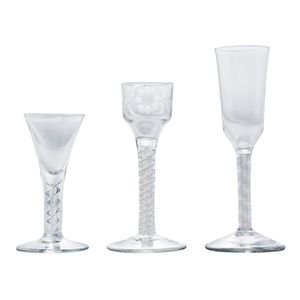Georgian Twist-Stem Glasses, 18th Century
Three Georgian twist-stem glasses, third quarter 18th century, a George II wine glass with a funnel bowl on an double corkscrew mercury air-twist stem and plain foot, an ale glass with tall ogee bowl on an opaque twist stem with a twisted gauze column within a spiral with a conical foot, and a cordial glass with ogee bowl engraved with floral sprays in Jacobite manner on a stem with a lace twist within an opaque spiral with a plain foot, the tallest 19 cm high. Provenance: all acquired from John Wilson Antiques in Melbourne, in 1981 and 1982
You must be a subscriber, and be logged in to view price and dealer details.
Subscribe Now to view actual auction price for this item
When you subscribe, you have the option of setting the currency in which to display prices to $Au, $US, $NZ or Stg.
This item has been sold, and the description, image and price are for reference purposes only.
- Twist - A rod of glass in which there is one or several threads or tapes of coloured glass, or bubbles of air embedded, which is then twisted to give an attractive appearance. The technique is mostly associated with the stems of Georgian glasses. The technique was in use from about the 1740s to the 1760s.
Collectors have identified over 150 variations of twist decoration. One of the most common is the air twist which as the name implies, has one or more columns of air embedded within the rod. A colour twist has one or more coloured tapes, usually opaque but sometimes translucent. other common types of twist include cable, corkscrew, enamel, gauze, lace, opaque and thread. - Stem - In drinking glasses the stem is that section of the glass that joins the bowl to the foot. In mass produced glasses is usually solid and of cylindrical shape, but in antique drinking glasses it may be long and short and in various styles or with decoration, such as air twist, baluster, collared, faceted, hollow, knopped, teardrop, twisted or incised.
- Georgian - As an English stylistic period, Georgian is usually taken to cover the period from George I (1714) to the Regency of Prince George (1811-20), although the period from 1800 to 1830 is sometimes designated as the Regency period. During the Georgian period the great English cabinetmakers and designers such as Chippendale, Hepplewhite, Adam Sheraton etc., were all active.
Therefore there isn't a single 'Georgian style' as such and to say something is 'Georgian', usually means it was made between 1714 and 1830. This assumes we discount George V and George VI, both being from the 20th century.
The styles popular at the time of each reign were:
George I (1714-1727) saw out the last years of the Baroque period.
George II (1727-1760) reigned during the Rococo period.
George III (1760-1820) saw the last gasp of the Rococo, all of the early Neo-Classic 'Adam style' and most of the later neo-Classic 'Regency style'.
George IV (Prince Regent 1820-1830)encompassed the last of the 'Regency' style.
William IV's reign (1830-1837) was something of a no man's land (stylistically) and he wasn't a 'George' anyway. He covered the last glimmerings of 'Regency' and the start of the 'Victorian' style. - Engraved Glass - The method of decorating glass by marking the surface with a sharp intrument such as a diamond, metal needle or rotating cutting wheel. As pressure is applied to the surface, best results for engraving are achieved if the glass is of sufficient thickness. In the 19th century etching was used to decorate some table glassware that was too fine to take an engraving tool.
- Bowl - With drinking glasses, the bowl is the hollow section of the glass that holds the liquid. Many glasses were mounted on a stem joined to a foot, others were cylindrical, of tumbler shape. The size and shape of the bowl was determined by the type of liquids they were meant to hold. Shapes used included bell shaped, conical (funnel), bucket shaped, trumpet, cup, ogee, funnel, cylindrical and rounded.
- Jacobite - Wine glasses engraved with mottos and symbols of the Jacobites, who were supporters of Prince Charles Edward Stuart's claim to the English throne.
They were passed around amongst the members of secret groups devoted to the restoration of a Catholic monarch in Scotland and England under the House of Stuart.
The last Jacobite Rebellion ended with Charles Edward Stuart?s defeat at the Battle of Culloden in 1746. His image features on some of the Jacobite glassware.
Genuine examples of Jacobite glassware are dated between 1746 and 1788 but many later copies and forgeries are in circulation.
In November 2012 a Jacobite "Amen" glass, the rarest group of Jacobite glasses sold for £43,000 at auction in Shropshire, England. - George Ii - George II (1683 - 1760) was King of Great Britain and Ireland from 1727 until his death in 1760.
This item has been included into following indexes:
